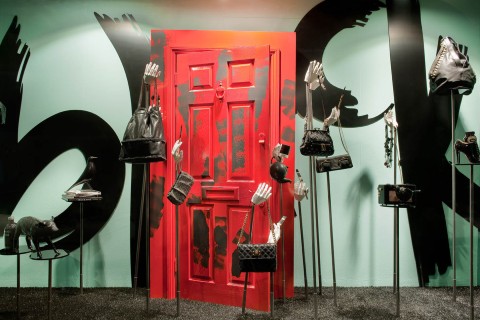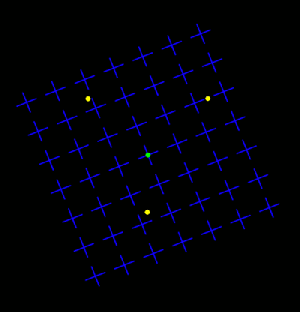Excellent
(100 - 90) |
Good
(89 - 80) |
Average
(79 - 70) |
Weak
(69 - 65) |
Incomplete
(65 or lower) | |
Logo placed on both mood boardS
(should match brand concept)
| |||||
Sample pictures
Fixtures, lighting, and props/decor
(Should be accurate)
| |||||
5 Color/Fabric Samples
(Does not have to be actual fabric, can be photos or clippings)
| |||||
Floor Plan
(Use of PowerPoint, 3D Design Layout, or Drawing)
| |||||
Detail and Craftsmanship
(Is it neat & well organized)
| |||||
Use of time
Speak for at least 5 minutes
(Introduce brand
Describe both mood boards
Why colors, why logo, why fixtures, why chosen floor plan, who is target market)
| |||||
Overall
|
Saturday, February 25, 2017
Store Logo and Floor Layout Rubric
Store Logo & Floor Plan Due 3/16/2017
Project Directive
- Create a store logo
- Create a summary of the store environment based on information in class and consumer profile
- Create a two board presentation.
- One board will feature mood and concept images.
- Concept images include pictures of fixtures, lighting, and props/decor
- On the second board, please draw a floor plan and color story for the store.
BOARDS ARE DUE – Thursday, March 16th.
Begin research and bring materials to class 3/2/2017


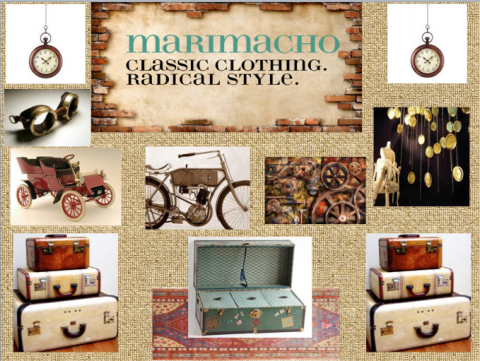

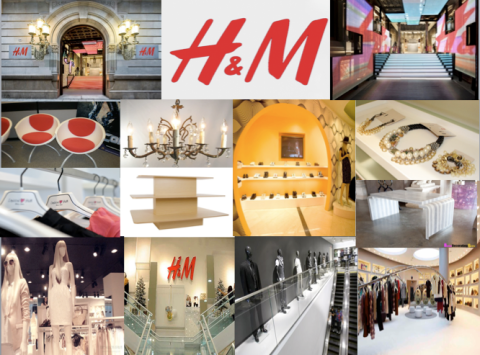
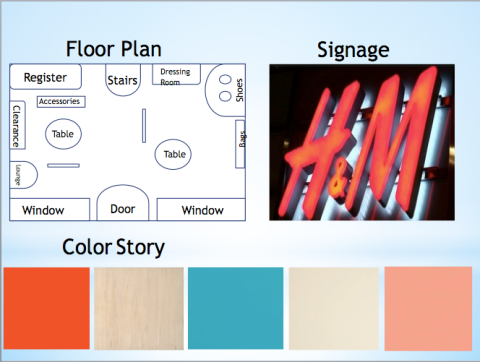
^^^^ ABOVE LINK CAN ALSO BE USED TO CREATE A STORE LAYOUT
- PLEASE COMMENT BELOW WITH QUESTIONS
Monday, February 20, 2017
Types of Display
One Line Item Display
• Showing or advancing a single garment or item
Line of Goods Display
• One type of merchandise – ie all blouses, all pots and pans
Related Merchandise Display
• Items shown together because they are meant to be used together
Variety or Assortment Display
• melange of anything and everything

Promotional vs. Institutional Displays
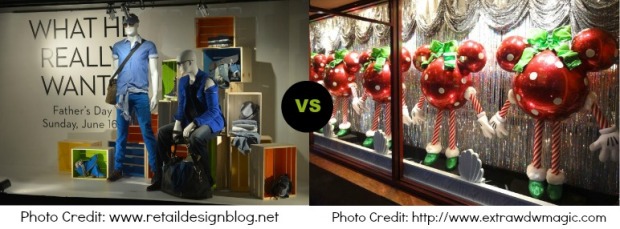
Types of Display Settings
Realistic Setting
• a room, area or other recognizable locale
Environmental Setting
• merchandise presentation that shows an assortment of various related items in a setting depicting how and where they may be eventually used.
Semi-realistic Setting
• a vignette setting that indicates while leaving the imagination to fill in the details
Fantasy Setting
• creative, fantasy, surreal
Abstract Setting
• an arrangement that does not look like anything in particular but evokes certain feelings

Build-up Display
• An overall display that has a build up of product – like blocks

Thursday, February 16, 2017
Lighting & Display
Lighting Prezi
Display & Settings Prezi





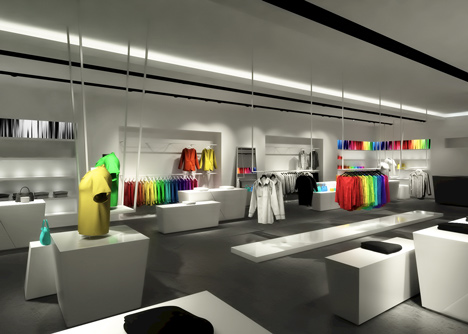
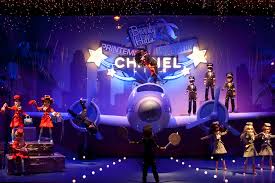
Display & Settings Prezi
The Color Of Light
• Light makes things visible
• All color depends on light
• All color depends on light
Kinds of Light
1. Natural Light
2. Artificial Light
• incandescent
• florescent
• high intensity discharge (HID)
2. Artificial Light
• incandescent
• florescent
• high intensity discharge (HID)
Visible Light
• Is composed of the whole spectrum of light from violet to red.
• All light is caused by waves of radiant energy that vary in length from shortest (violet) to longest (red)
• Ultraviolet, x-rays and gamma rays are too short to see, infrared and radio waves are too long.
• All light is caused by waves of radiant energy that vary in length from shortest (violet) to longest (red)
• Ultraviolet, x-rays and gamma rays are too short to see, infrared and radio waves are too long.
Some light sources reflect the shorter waves and appear more blue, some the longer and have a warmer tone.
The Color of an Object
Is the result of the object’s absorption of color waves:
i.e – a blue object absorbs all the waves but the blue ones
Black absorbs all waves
White reflects all waves
i.e – a blue object absorbs all the waves but the blue ones
Black absorbs all waves
White reflects all waves
Planning Window Lighting
An unlit or poorly illuminated window becomes a giant one-way mirror.
The cheapest and most effective way to get attention and recognition is good lighting
The cheapest and most effective way to get attention and recognition is good lighting
The Open Back Window
Lighting in the display area must be strong enough and bright enough to attract and keep the eye from going past the feature merchandise.
• focus light away from the glass
• avoid lighting the mannequin’s face – chest lighting is best.
• place the merchandise as far back as possible to prevent conflict with daylight
• create a backdrop with fabric, screen, wood, plants
• focus light away from the glass
• avoid lighting the mannequin’s face – chest lighting is best.
• place the merchandise as far back as possible to prevent conflict with daylight
• create a backdrop with fabric, screen, wood, plants
A great opportunity for magical lighting effects
• Paint the background with light
• dramatize the scene using colored lights or gels
• used patterned filters or gels
• put the merchandise as far back as possible
• Paint the background with light
• dramatize the scene using colored lights or gels
• used patterned filters or gels
• put the merchandise as far back as possible
Light
Directs the shopper’s attention from one presentation to another, points out focal points and displays
Store Lighting Plan
Includes overall illumination of the space and also the accents that point things out.
• wall lighting can show off wall stock
• careful lighting necessary at “moment of truth” spots.
• wall lighting can show off wall stock
• careful lighting necessary at “moment of truth” spots.
General or Primary Lighting
All over illumination that fills the selling floor.
Florescent
Least expensive and most energy efficient. It can appear flat, even, cool. Provides little depth. Can be accented with other lighting.
Makes some things, (silverware, jewelry) sparkle, but skin tones are not flattered. Enhance with an incandescent near the mirror)
Are covered by baffles or grids.
Compact Florescent Lights
Incandescent Lights
Warm, short lived, energy inefficient. Being phased out.
High Intensity Discharge Lights (HID)
Comes in a range of colors, useful as spots.
MR16 and MR11
Miniature, low voltage tungsten-halogen lamps that emit sharp bright light and produce a color balance close to sunlight.
Metal Halide Lamps
Especially effective for spotlighting and accenting product displays or creating pools of dramatic lighting.
LED (light emitting diode)
Small, long lived and versatile.
Secondary or Accent Lighting

Colored Lights and Filters

Spotlights

Accent Lights

Planning Store Lighting
Proper Lighting requires a palette of lamps and light sources to create a total effect.
Using Light Effectively
• Avoid Green – it accentuates blemishes. Pink is universally flattering
• Avoid bright white lights on mannequins face, elbows or shoes
• Use colored light to create the SETTING for merchandise
• It is better to light ACROSS the display than directly DOWN on it
• Check to see that the lighting works at night
• Hide your wires.
• Avoid bright white lights on mannequins face, elbows or shoes
• Use colored light to create the SETTING for merchandise
• It is better to light ACROSS the display than directly DOWN on it
• Check to see that the lighting works at night
• Hide your wires.
Monday, February 13, 2017
Assignment #2 Due 2/27/2018
Analyze and name at least seven keys to window display success, and explain why you think they are important.
- Find three 3 windows to analyze (two online, one must be from field research)
- You may choose any type of merchandise.
- What is the theme conveyed in each presentation?
- Discuss Brand Image
- Report your findings to class using a PowerPoint Presentation or Prezi (at least 5 slides) along with one page of text. Presentation should last five minutes.
- Please use MLA format for works cited.
We will also work on this in class.
PLEASE LEAVE QUESTIONS AND COMMENTS BELOW
- Find three 3 windows to analyze (two online, one must be from field research)
- You may choose any type of merchandise.
- What is the theme conveyed in each presentation?
- Discuss Brand Image
- Does the display align with the brand image? Why or Why Not?
- Report your findings to class using a PowerPoint Presentation or Prezi (at least 5 slides) along with one page of text. Presentation should last five minutes.
- Please use MLA format for works cited.
We will also work on this in class.
PLEASE LEAVE QUESTIONS AND COMMENTS BELOW
Thursday, February 2, 2017
Color & Texture
COLOR AND TEXTURE PREZI
PLEASE CLICK THE ABOVE LINK FOR INFORMATION AND REVIEW OF THE LESSON ON COLOR AND TEXTURE
“Color is the biggest motivation for shopping. People buy color before they buy size, fit or price”
Color Psychology
People react to color in some common ways. However, individual responses can vary.
The display person will not be able to provide the ideal setting for each customer, but can satisfy the majority.
Yellow:
Sunshine, happy, bright, cheerful, fun, alive. Spring, summer, Easter.
Orange:
Friendly, sociable, agreeable, glowing, exciting, vibrant and filled with anticipation.
Can be harsh or indicate danger.
Can be harsh or indicate danger.
Red:
Exciting, stimulating, powerful and sexy. Strong and passionate. Valentine’s, Christmas, Patriotism.
Conveys “Sale.” Can also be warning or fire.
Conveys “Sale.” Can also be warning or fire.
Pink:
Sweet, lovely, pretty, girly. Mother’s Day, Easter, lingerie. Can seem insipid or fleshy.
Green:
Cool, alive, growing. Springtime, lawns, forests, eco-consciousness. Good for St. Patrick’s Day or Christmas. Darker greens can be military, pale greens can look institutional.
Blue:
Most popular color. Cool, comfortable, calm. Skies, lakes, flags. Shadows on snow, home, summer water, flags. It is quiet but can be moody or depressing.
Blue-green:
Cool, tasteful, sensitive and restful. Vital and alive, yet quiet. Water, sea, sky and grass.
Peach:
The warmth and excitement of orange without the grating qualities. Smiling, glowing it is easy to be with and delightful to be in. A pastel earth tone.
Rust:
Full bodied, the warmth of orange but not irritating. The color of autumn.
Purple:
Traditionally regal, it is now associated with children – happy and youthful. In deeper tones it is taste, distinction. Can be overbearing or pompous.
Gray:
Makes no statement and supports other colors well. Depressing or super-elegant and sophisticated.
Brown:
Earth, hearth, home, family, farm, wood, clay. A warm nuetral that lets other colors step forward, but unlike gray, does not disappear.
White:
Blank, but supports other colors well, making them brighter. Innocence, hope, angels, summer, clarity. Can also seem stark or sterile.
Black:
Night, mystery, absence, sex, death, intrigue, sophistication. Ultra-chic or ominous, it is a neutral that requires careful handling.
Color Families:
Warm – reds, yellows, oranges
Cool – greens, blues
Neutrals – Black, white, gray, brown
People of certain ages and types respond best to certain families. Elegant items show best against neutrals, while younger customers like warm brights.
Color Stories:
Analogous – create a close and pleasing harmony
Complementary – use with care and attention to proportion.
The Pantone website – http://www.pantone.com
Color Tools Website – http://www.colourlovers.com/
Subscribe to:
Posts (Atom)













